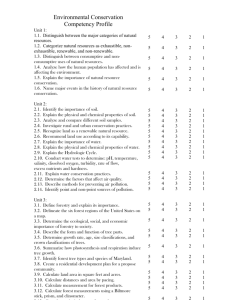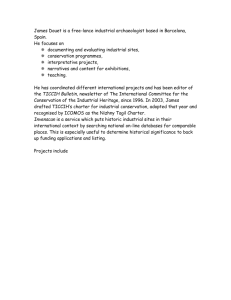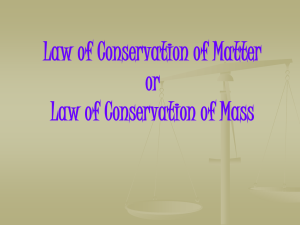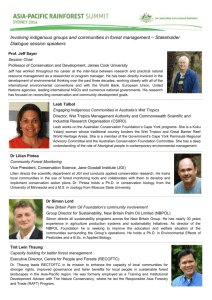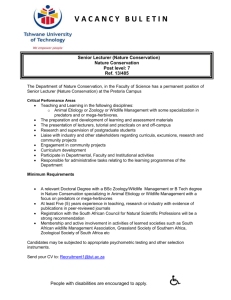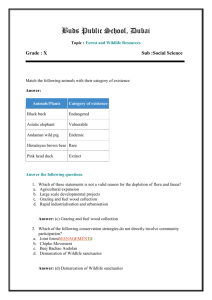Land Nationalization and community conserved areas
advertisement
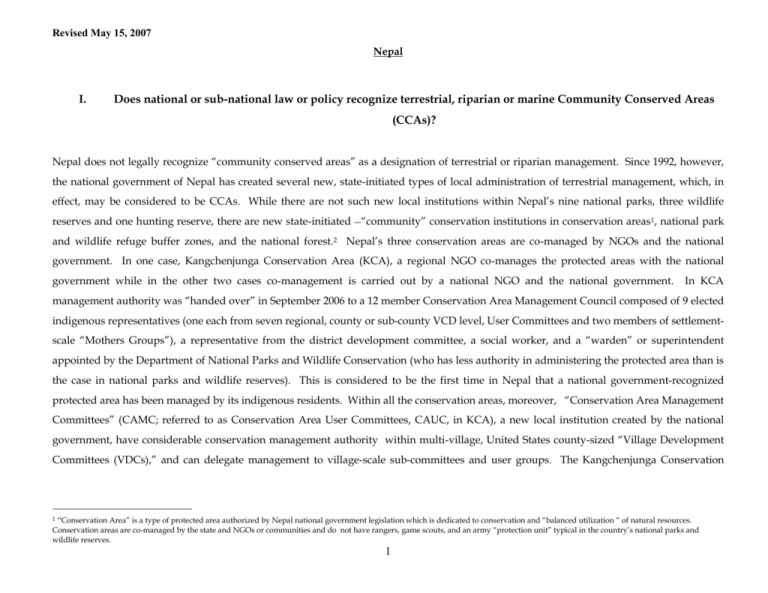
Revised May 15, 2007 Nepal I. Does national or sub-national law or policy recognize terrestrial, riparian or marine Community Conserved Areas (CCAs)? Nepal does not legally recognize “community conserved areas” as a designation of terrestrial or riparian management. Since 1992, however, the national government of Nepal has created several new, state-initiated types of local administration of terrestrial management, which, in effect, may be considered to be CCAs. While there are not such new local institutions within Nepal’s nine national parks, three wildlife reserves and one hunting reserve, there are new state-initiated “community” conservation institutions in conservation areas1, national park and wildlife refuge buffer zones, and the national forest.2 Nepal’s three conservation areas are co-managed by NGOs and the national government. In one case, Kangchenjunga Conservation Area (KCA), a regional NGO co-manages the protected areas with the national government while in the other two cases co-management is carried out by a national NGO and the national government. In KCA management authority was “handed over” in September 2006 to a 12 member Conservation Area Management Council composed of 9 elected indigenous representatives (one each from seven regional, county or sub-county VCD level, User Committees and two members of settlementscale “Mothers Groups”), a representative from the district development committee, a social worker, and a “warden” or superintendent appointed by the Department of National Parks and Wildlife Conservation (who has less authority in administering the protected area than is the case in national parks and wildlife reserves). This is considered to be the first time in Nepal that a national government-recognized protected area has been managed by its indigenous residents. Within all the conservation areas, moreover, “Conservation Area Management Committees” (CAMC; referred to as Conservation Area User Committees, CAUC, in KCA), a new local institution created by the national government, have considerable conservation management authority within multi-village, United States county-sized “Village Development Committees (VDCs),” and can delegate management to village-scale sub-committees and user groups. The Kangchenjunga Conservation “Conservation Area” is a type of protected area authorized by Nepal national government legislation which is dedicated to conservation and “balanced utilization “ of natural resources. Conservation areas are co-managed by the state and NGOs or communities and do not have rangers, game scouts, and an army “protection unit” typical in the country’s national parks and wildlife reserves. 1 1 Area Management Council and the CAMCs/CAUCs and other institutions must abide by national conservation area policies (for example the national ban on hunting in protected areas) but are otherwise empowered with considerable authority to devise and implement local conservation policies. In the case of the buffer zones, which have been established adjacent to most national parks and wildlife reserves (and which can include settlement enclaves within national parks), three different scales of local and community conservation management institutions have been established. These are a Buffer Zone Management Council with one local representative from each Buffer Zone Users Committee, one Buffer Zone Users Committee for each VDC or other area defined by the national park or wildlife reserve superintendent, and one or more Buffer Zone Users Groups at the local VDC ward scale (wards vary in size from neighborhoods of large villages to micro-regions which include multiple settlements). In the national forest Community Forests User Groups (CFUGs) have been established at settlement and multi-settlement VDC scales. As discussed in section III, these are new institutions which do not necessarily acknowledge earlier community and indigenous peoples’ institutions, policies, and practices. They are based on new local administrative geographies which often ignore customary village land boundaries and management of commons and instead group multiple villages into new administrative units. Buffer zone establishment has also in some cases provided national park and wildlife reserve administrators with considerable policy-making, institutional oversight, and budget allocation authority within the buffer zone. Pre-existing “customary” CCAs (many of which continue in operation), such as community management of sacred places and collectively used forests and grasslands, have not been recognized in law or policy. The category of “religious forests,” which is a legally authorized form of devolving management authority over national forest lands from the national government in the national forest and in buffer zones, offers a potential means to recognize customary sacred forests. Customary sacred forests, however, have often not been recognized as religious forests within national forests or in buffer zones. No figures are available on the number or area of religious forests, in contrast to readily available figures on the number of community forest users groups and the areas they administer. Nepal has designated most of its forests as its “national forest” under the management of the district forest offices (DFO) and the supervision of the Ministry of Forests and Soil Conservation. Some areas of the national forest have been “handed over” to management by “community forest users groups.” Unlike the practice in some countries, the “national forest” has not been divided into multiple, individually demarcated and named national forests. 2 2 Conservation Areas (CA) CA Management Council or National Trust for Nature Conservation Manage/Co-manage CA as a whole CA Management Committee/CA Users Committees Jurisdiction in all or part of a VDC User Groups Jurisdiction in VDCs at ward or settlement level for specific administrative functions Buffer Zone Buffer Zone Management Council Manage Buffer Zone as a whole II. Buffer Zone User Committees Jurisdiction in all or part of a VDC and in multi-VDC areas Buffer Zone User Groups Jurisdiction in VDCs at ward or settlement level for specific administrative functions Does the country recognize CCAs as a part of the PA network system? Nepal does not recognize CCAs as such as part of the national protected area system. However, the Nepal protected area system currently includes conservation areas and buffer zones, both of which have within them one or more scales of local administrative institutions (the Conservation Area Management Council and Conservation Area Management Committees/User Committees in conservation areas and Buffer Zone Users Councils, Committees, and Groups in buffer zones). These can be considered non-traditional CCAs. In the case of conservation areas, CAMCs/CAUCs and CAUGs have in the past functioned as CCAs within protected areas which are co-managed at the 3 scale of the protected area as a whole by the national government and a national NGO (the National Trust for Nature Conservation – formerly the King Mahendra Trust for Nature Conservation) and also formerly by World Wildlife Fund-Nepal. Since September 2006, when comanagement authority and de facto management authority was handed over to a regional NGO (the Kangchenjunga Conservation Area Management Council) in Kangchenjunga Conservation Area, this conservation area might be considered to be an example of a CCA at the scale of the entire protected area. Here – as in other conservation areas – much conservation management authority continues to be held by the locally-elected Conservation Area Management Committees/User Committees, which in effect function as CCAs within various regions of the conservation area which are often the homelands of different peoples. These Conservation Area Management Committees/User Committees can accordingly be considered to be national government established CCAs. Pre-existing, often still extant CCAs including sacred places and community-managed forests, grasslands, and alpine commons, however, are not inherently recognized within conservation areas or in the rest of the Nepal protected area system. Conservation Area Management Committees/User Committees in conservation areas, Buffer Zone Users Committees and User Groups, and Community Forest Users Groups, may in some cases incorporate customary CCA management goals and regulations into their working plans and rules. There is no guarantee of this, however, and customary CCAs may often be ignored when indigenous peoples are marginalized within multi-ethnic “local” scale “community” management institutions. Traditional institutional structures and management practices for indigenous and local community customary CCAs may often be undermined and lost. This is not currently documented. Community forests users groups in the national forest are not recognized as part of the PA network system because in Nepal the national forest is not regarded as part of the PA network system and the national government of Nepal has not reported it to IUCN’s World Commission on Protected Areas (WCPA) or the World Database on Protected Areas (WDPA) for recognition and inclusion in the UN List of Protected Areas and the World Data Base on Protected Areas. III. If CCAs are not legally recognized, are there general policies/laws that recognize indigenous/community territories or rights to areas or natural resources, under which such communities can conserve their own sites? The Nepal government first recognized indigenous peoples as such (officially adivasi/janajati) by executive order in 1997 and by national law in 2002. Currently, 59 such peoples have been identified by the Nepal government. As of mid-2007, however, the government of Nepal has 4 not recognized indigenous territories or community territories. The Nepal Federation of Indigenous Nationalities and some other national indigenous peoples’ organizations advocate the establishment of autonomous regions for various indigenous peoples. Collective ownership of forests or rangelands by communities is not recognized in Nepal law. Indigenous peoples and other local communities do not have rights to the use of natural resources in the areas in which they reside, but some uses can be authorized by protected area administrators in some of the national parks and in buffer zones, as well as in the community forests within the national forest. The National Parks and Wildlife Conservation Act of 1973 bans many customary natural resource activities including hunting and grazing. Very limited natural resource use (such as grass harvesting) is permitted in some national parks on a fee basis and subject to limited seasons and quantities. There is no recognition of an inherent right to use plants and animals in traditional religious activities. People who live in and around mountain national parks (but not lowland protected areas), however, are accorded conditional access to subsistence use of natural resources by the Himalayan National Parks Regulations of 1979. In several mountain national parks this has included collection of firewood and grazing. Customary use of natural resources or customary levels of natural resource use are not, however, rights. The regulations do not specify authorized natural resource use and the conditions of use in any detail. Within mountain national parks, management policies have tended to restrict the range of land uses permitted and often also the level of use of those permitted uses. Protected area laws, policies, regulations, and plans often have been developed with little participation by indigenous peoples and have been adopted and implemented without their consent. Land Nationalization and community conserved areas In Nepal almost all forest, all grasslands, and other non-cropped land such as the alpine areas, lakes, and rivers have been nationalized under the Private Forests (Birta) Nationalization Act of 1957 (which has been interpreted to include community owned and managed forests as private forests subject to nationalization) and the Rangelands (Pasture Lands) Nationalization Act, 1974. There has been no subsequent restitution of forest or grasslands to community ownership. All of the nationalized forest was formerly managed by the Department of Forests (DoF), and the DoF retains direct or supervisory authority over the management of the national forest (including shrubland, grassland, 5 wetland, lacustrine, riverine, and alpine areas within). Administrative authority of some former national forest land has been transferred to the Department of National Parks and Wildlife Conservation (DNPWC), another department within the Ministry of Forests and Soil Conservation and approximately 25% of the national forest has now been handed over to the management of communities. DNPWC is responsible for administrative oversight of protected areas (national parks, wildlife reserves, a hunting reserve, conservation areas, and buffer zones for national parks and wildlife reserves). Neither the DNPWC nor the DoF recognizes any inherent rights by communities to continue to manage lands according to customary or traditional institutions and practices. Customary or traditional institutions became illegal, although in some cases, as in Sherpa community management of grazing on national park rangelands, continued community management of commons has been tacitly authorized. Since the early 1990s, various new forms of “user committee” or “user group” based management have been established in buffer zones, conservation areas, and some national forest areas. These are not based on customary or traditional institutions or administrative areas. Their policies may or may not reflect customary practices. National Parks and Wildlife Conservation Act, Conservation Areas With the third amendment to the National Parks and Wildlife Conservation Act in 1989 the DNPWC began to co-manage conservation areas with NGOs. Until 2006 these NGOs were either the National Trust for Nature Conservation (formerly the King Mahendra Trust for Nature Conservation) or the World Wildlife Fund. In September 2006, however, the national government "handed over" legal co-management and effective, de facto management of Kangchenjunga Conservation Area to a local NGO, the first time that indigenous peoples have gained comanagement or management authority over a Nepal national government-recognized protected area. Local conservation management within conservation areas is largely carried out by local institutions. Under conservation area guidelines developed by the DNPWC in 1999, local administrative bodies known as “Conservation Area Management Committees” (and called Conservation Area User Committees in Kangchenjunga Conservation Area) are created and manage forests and other lands. These are not customary community institutions that manage village lands. Instead these institutions each administer all or part of the territory of a so-called “Village Development Committee (VDC),” a local administrative unit introduced by the Nepal national government in 1990 which typically combines the customary village lands of several (and sometimes scores) of settlements. The new Conservation Area Management Committees/User Committees manage forests, grasslands, and other lands under the supervision of NGOs and DNPWC and within national laws. They do not necessarily respect the customary regulations through which individual settlements formerly managed forests, grasslands, and sacred places, and there are no regulations or guidelines requiring or advising them to do so. 6 National Parks and Wildlife Conservation Act, Buffer Zones: Under the authority of the fourth amendment to the National Parks and Wildlife Conservation Act in 1993 the DNPWC has similarly handed over management authority over lands that include forests, grasslands, and alpine regions to several new local administrative bodies established within buffer zones at varying scales (Buffer Zone User Groups at the ward or settlement level, Buffer Zone User Committees at the VDC level (or sub-VDC or multiple VDC level as authorized by protected area superintendents), and a Buffer Zone Management Council for the entire buffer zone). The Buffer Zone Management Council, composed of the chairs of each of the Buffer Zone User Committees), the superintendent (chief conservation officer or warden) of the national park or wildlife reserve, and a district official, co-manages conservation in the buffer zone. In some cases effective authority may reside with the superintendent and the BZMC may become in effect an advisory body. Local administrative units (Buffer Zone Users Groups and Buffer Zone User Committees) manage forests and grasslands within the buffer zone. One (or more) Buffer Zone Users Groups administers one or more of the nine wards within each VDC. Because each ward typically contains multiple settlements, the use of this new administrative geography ensures that sacred places and community managed commons that were formerly administered by particular individual villages now come under the management of committees that include members from villages which formerly did not have access rights to them and who were not involved in the past in their management. The various buffer zone institutions manage or co-manage only buffer zone lands, and have no official role in the management of adjacent national parks or wildlife reserves. In the case of Sagarmatha National Park, however, the Buffer Zone Committees and the Buffer Zone Management Council have been integrally involved since 2002 in developing and administering new forest use rules for the national park forests. Community-based Management within the National Forest The Department of Forests has similarly “handed over” management authority over forests (and shrublands and grasslands) within the national forest to new local institutions (Community Forest Users Groups), which can be organized at the hamlet (ward), settlement, or multisettlement scale. These institutions manage forests and other areas under the supervision of district forest offices after adopting a Department of Forests-approved constitution and five-year operational plan. This institution enables communities to regain some degree of authority and control over managing local forests and an opportunity to adopt new forest management goals and procedures, including permit and fee systems and regional working plans intended to maintain sustainable use and provide community and government revenue. 7 The opportunity to regain a measure of control over and benefit from local forests may be welcomed by communities, although the new institutions, procedures, policies, and conservation goals can be controversial within communities when new conceptions of conservation, new decision-making processes, and new resource use allocation, restrictions, and procedures conflict with customary values, institutions, and practices and when they are considered to unequally benefit and disadvantage particular individuals and social groups within what are often politically, socially, ethnically, and economically differentiated communities. Community-based Management in National Parks The 2006-2011 Sagarmatha National Park and Buffer Zone Management Plan envisions zoning the national park into two types of zones: “community resource areas” and “special areas.” Buffer zone residents residing in the enclave settlements within the national park would have access to some natural resources within these national park zones (particularly in community resource areas) and may be involved in the management of forest use, grazing, and other land use in them. Details of these arrangements, including whether and how communities participate in management of land use in the new zones, have yet to be worked out. Overall Policy Strengths : 1. Since the late 1980s, the national government of Nepal has recognized several forms of community-based conservation within its protected area system and has "handed over" considerable management authority to local institutions in conservation areas and in buffer zones in and around national parks and wildlife reserves. Management authority of a substantial part of the national forest has also been "handed over" to communities. 2. The current institutions have transferred some degree of decision-making and management from the central government to communities in conservation areas, buffer zones, and community forests within the national forest. They have also increased access by indigenous peoples and local communities to natural resources (except within national parks and wildlife refuges). Despite decentralization the degree to which 8 communities have authority over policy-making and planning may vary. In particular, communities have been very little involved in national park management. 3. Since 1992, three conservation areas have been established, encompassing 9,827 km2. These constitute three of the four largest protected areas in Nepal. Annapurna Conservation Area (7,629 km2), Nepal’s largest protected area, is more than twice the size of any other protected area in the country and is home to more than 100,000 people living in more than 300 villages. Since 1996, eleven protected area buffer zones have been established in association with national parks and wildlife reserves, constituting nearly 5,000 square kilometers of the 28,999 square kilometer protected area system that now encompasses 19.7% of Nepal (including buffer zones but not including the national forest). As of 2005, 153 buffer zone community forestry user groups had been established. The eight buffer zones established adjacent to national parks have an area of 4,365 km2 and encompass 144 VDCs. In 2006 they were inhabited and managed by an estimated 70,000 households (447,000 people). Approximately 25% of the national forests, an area of 1.2 million hectares, had been handed over by 2005 to more than 14,000 community forest management committees. Some 1.6 million households (7.7 million people), more than 25% of the population of Nepal, are involved in managing community forests. Weaknesses: There are a number of continuing weaknesses in the current level of recognition of community conserved areas within protected areas and the national forest. These include lack of recognition of indigenous peoples’ territories, collectively-owned land, customary collective management of commons and sacred places, and customary use of biological resources in accordance with traditional cultural practices and conservation goals 1. The government of Nepal has legally recognized some indigenous peoples but has not yet signed ILO 169 or legally recognized many of the indigenous rights specified in it. 9 2. Nepal’s protected areas (including buffer zones) were established by government decrees without prior, free, informed consent by resident indigenous peoples and other local communities. Although indigenous peoples and other local communities were sometimes consulted in the process of protected area establishment and development through the convening of village meetings, this did not constitute prior consent. 3. Indigenous peoples and other local communities have been involuntarily displaced through eviction from several of Nepal’s national parks and wildlife reserves. Indigenous peoples reportedly have been involuntarily evicted from Rara National Park, Chitwan National Park, Bardia National Park, Kosi Tappu Wildlife Refuge, Suklaphanta Wildlife Reserve, and Parsa Wildlife Reserve. 4. Indigenous peoples and other local communities have been "economically displaced" because of national government imposed bans or restrictions on their customary access to natural resources (including the use of natural resources for religious practices) from all of Nepal's national parks, wildlife reserves, conservation areas, and hunting reserves, from many of its buffer zones, and from many areas of its national forest. Indigenous peoples often were not consulted on the implementation of these policies and did not give their free, informed, prior consent to them. 5. Indigenous peoples and other local communities were little involved in decision-making about land management and conservation in protected areas prior to the 1990s, and since then their involvement has been limited to conservation areas, buffer zones, and community forests within the national forest. They remain little involved in the management of the national parks or the wildlife refuges. 6. The government of Nepal does not recognize indigenous territories, community territories, or community ownership of land. Nearly all forests and grasslands have been nationalized in the past half-century and none has been restored to community ownership. 7. Customary systems of collective management of land, including forest and rangeland commons, are not recognized in protected areas or the national forest. New, nationally developed local institutions introduced in buffer zones, conservation areas, and community forests often do not incorporate customary community practices of managing natural resource use or protecting sacred places. 10 8. Many customary uses (economic and cultural) of biological resources by indigenous peoples are not fully recognized in protected areas. Typically some activities are banned while others may be restricted in season and in level of use. 9. Local administrative units of land management in protected areas and community forests have been devised and territorially delineated by the national government and often do not reflect customary or traditional patterns of community land ownership and administration. This can undermine customary, settlement-based management of commons and protection of sacred places by ignoring communities’ customary or traditional governance institutions, conservation goals, and land use regulations. 10. Little use has been made thus far of the designation of “religious forests” in buffer zones or the national forest. This misses an opportunity to acknowledge pre-existing community conserved areas. 11. There is no national legal basis for the identification and protection of sacred places or for assurance that indigenous peoples will continue to have access to and control over their management. There are likely thousands of sacred forests, mountains, lakes, and other community conserved areas within the regions inhabited by indigenous peoples and other local communities. Communities have lost their ownership of these with land nationalization. Villages often no longer have control over decisions about the protection of their sacred sites because new land management institutions in conservation areas, buffer zones, and community forests are based on regional, multi-village governance rather than on governance by individual villages. 12. Until very recently, when co-management authority over Kangchenjunga Conservation Area was handed over to a local NGO, indigenous peoples did not manage or co-manage any of Nepal’s protected areas. The government of Nepal does not recognize any inherent right for indigenous peoples to be involved in the management of national parks and wildlife reserves. Following a national government policy initiative in 2003, however, management or co-management of some (but not all) national parks, conservation areas, and wildlife refuges can be "handed over" to NGOs, including local NGOs. Such NGOs, even when locally created, however, may not constitute elected, representational governance and may not incorporate or recognize indigenous peoples' customary governance institutions and natural resource management practices. 11 IV. Overall Comments 1. Nepal has a worldwide reputation for progressive, community-based conservation in its conservation areas, buffer zones, and national forest. Nepal has -- in effect if not by name -- recognized newly-established community conserved areas within these protected areas and areas of the national forest. These are, however, new institutions. Nepal has yet to adopt policies which recognize and support “customary” or “traditional” CCAs such as sacred places and community-managed commons in either its current protected area system or its nationalized forests. 2. A comprehensive recognition of customary CCAs in Nepal would have enormous indigenous rights and conservation significance. Indigenous peoples constitute at least 37% of the country’s population. Most of these more than eleven million people continue to live in rural areas, many of them in customary homelands. They and other local communities historically have respected and conserved a vast number of collectively-managed forest and grassland commons and sacred places. A large number of these systems may still be in use despite lack of legal recognition, and indigenous peoples and local communities may wish to revive others. 3. Formal recognition of CCAs throughout the Nepal protected areas and the national forest would likely require amendments to several government acts, including the National Parks Act (or a new Protected Areas Act), the Himalayan National Parks Regulations (and individual protected area acts), and the Forests Act. Guidelines, regulations, and rules devised by the DNPWC for national park buffer zones and conservation areas, and by the DoF for community managed forests, should also be evaluated and revised to recognize CCAs and to come into accord with current IUCN guidelines for protected area establishment and management in regions inhabited by indigenous peoples and local communities. 4. It would be appropriate for the government of Nepal to consider evaluating the suitability of its national forest for inclusion on the UN List of Protected Areas. Large areas of the national forest could be classified as IUCN Category V or VI protected areas, including areas managed by Community Forest Users Groups 12 5. Linking national recognition of CCAs within Nepal’s protected areas and national forests with enhanced indigenous rights recognition is also advisable. Although Nepal is often commended for its recognition of community-based conservation in its protected area system and its community forestry programs, from the standpoint of CCAs and the recognition of the rights of indigenous peoples within and around protected areas these vary enormously in how well they meet international standards adopted by IUCN for the establishment and management of protected areas in regions inhabited by indigenous peoples. There are important shortcomings with regard to acknowledgement of the rights of indigenous peoples and customary community-based conservation even in the most progressive protected areas in Nepal (the three conservation areas and the buffer zones) and the Community Forest User Group-managed areas of the national forest. These shortcomings are more pronounced in the national parks and wildlife reserves. Key concerns are recognition of collective territorial governance and collective land ownership, restitution of lands which have been nationalized, informed consent by indigenous peoples to the establishment and operation of protected areas, access to customarily used natural resources for economic and cultural purposes, and greater recognition of the rights of communities to manage natural resources and participate in conservation and development on the basis of their own systems of governance and their knowledge, values, beliefs and practices. Prepared by: Dr. Stan Stevens, Associate Professor of Geography, Department of Geosciences, University of Massachusetts, Amherst, MA 01003, USA. Email: sstevens@geo.umass.edu 13

